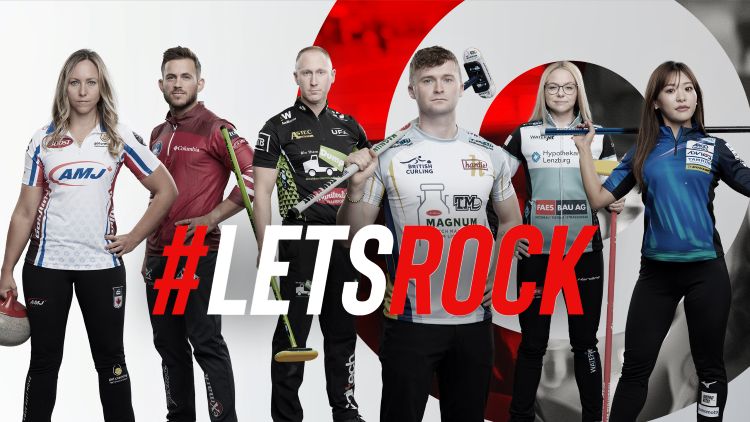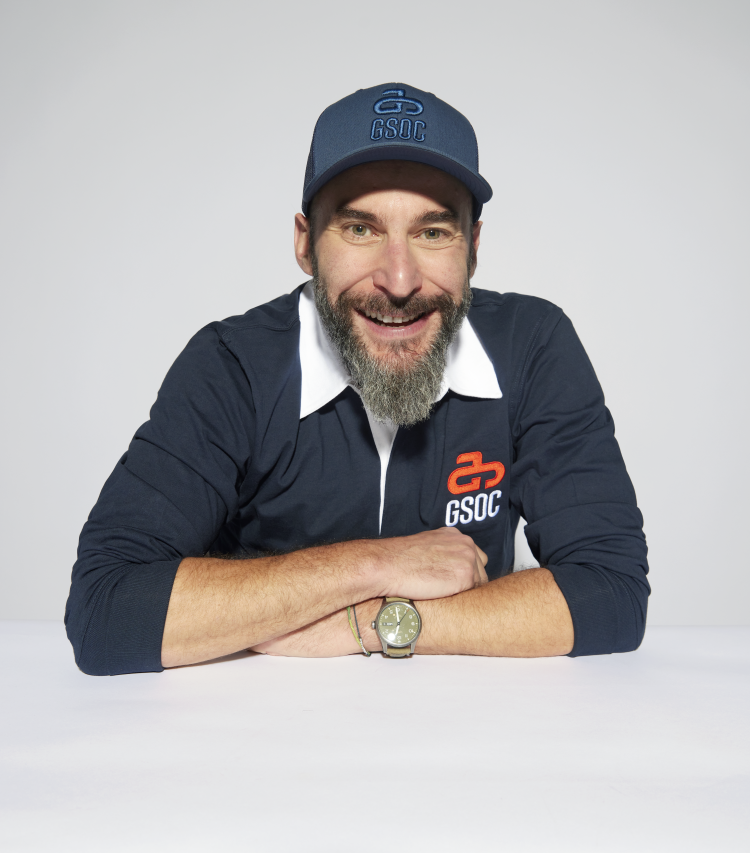The Curling Group’s bet on global curling

By Ernest Granson
Many years ago, the venerated comedy SCTV aired a parody TV promo which featured the beloved John Candy and future Schitt’s Creek star, Eugene Levy. Candy and Levy (the two Gords in the video) wear excruciatingly painful orange blazers as CBC commentators for the imagined Monday Night Curling. In the segment, curling instructor Howie McMeeker, dressed in outlandish plaid pants and a Tam o’ Shanter, knocks over a young curling student in his zeal to illustrate how to correctly throw a rock from the hack (indented footgrip in the ice). McMeeker, for the uninitiated, was a play on the name Howie Meeker, who was a former NHL star, hockey broadcaster and educator. In the skit, curlers sweep a rock frantically down the rink with now old-school corn brooms while the two commentors furiously shout out the action. The SCTV writers were having a lot of fun with the idea that the sport of curling could be considered on the same excitement level as that great American tradition – Monday Night Football.

Back to the present and the sports venture company, The Curling Group (TCG) is banking that curling can generate that NFL football level of excitement along with an accompanying financial windfall. In April of 2024, TCG acquired ownership of the Grand Slam of Curling competition from Sportsnet and secured just under US$7 million in seed funding to “take the sport of curling to new heights through strategic investments, innovation, and content production” according to a company press release. The round was led by Toronto-based venture capital firm Relay Ventures.
Also, according a TCG press release: “The rise in curling’s popularity is reflected in the interest of pro athletes and celebrities, including former NFL star Jared Allen and current NFL stars George Kittle and TJ Hockenson, who are all a part of The Curling Group’s initial group of investors. Two-time Olympic gold medal curler John Morris and Olympic gold medal curler Jennifer Jones are also serving as strategic advisors.”

Behind this major effort to put the sport of curling on the world map and to put meaningful money into the bank accounts of curling athletes is Nic Sulsky, former chief commercial and revenue officer of Ontario’s regulated online bookmaker PointsBet Canada and former president of fantasy sports company Monkey Knife Fight. Prior to his online career, Sulsky developed his skills as a TV/video personality, producer and content provider. He was a regular contributor and guest on TSN’s former talk show Off the Record with Michael Landsberg.
An athlete, but not what you call a curling aficionado (although he has curled a few times, he says), Sulsky’s passion for the sport was ignited when PointsBet became a sponsor of major curling events.
“I was taken aback by how different it was than I thought it was going to be,” Sulsky says. “It’s always been interesting to me when you get caught up in stereotypes and then experience something with your own eyes which breaks down that stereotype. Because if I experienced this, I’ll bet there many others that could probably have that similar experience.”
But it wasn’t only what he experienced as a spectator which impressed Sulsky, it was the personalities of the curlers. “When I got to meet the curlers, I found they were such amazing people,” he says, “and I also realized what incredible athletes they are. I saw an opportunity around rebranding and reinvigorating a sport that has an incredible amount of history, including being in the Olympics, that had started to grow around the world. That is what drew me to it to the sport.”
It's one thing to believe in and commit to an opportunity – it’s another to make that opportunity pay off. In the case of the sport of curling, trying to attract spectators and their ticket revenue is an important goal, but sponsorship revenue is crucial. Sulsky says this is fundamental to just about all sports. “The foundation of sports business is sponsorship revenue,” he says. “In order to trigger sponsorship revenue, you need to have eyeballs and engagement. In order to get that, you need to have distribution partners, whether it’s on linear, digital or streaming platforms. The great thing about the Grand Slam of Curling (GSOC), which is the first asset we acquired, is that Sportsnet has done a great job over 12 years building up the property. Sportsnet is maintaining the linear broadcast in Canada, so I knew in Canada, at least, we would have a solid foundation by way of distribution that would allow us to capitalize on sponsorship within this country.”
According to The Curling Group’s numbers, it grew its Grand Slam TV audience on Sportsnet by 16% in Canada over its first year of operation of 2023-24 with a national reach of 5.3 million. It launched its international streaming offering in 2024-25 producing streams for each game, garnering a global reach of 6.5 million throughout the season. Important to note is that more than half of its viewers are between the ages of 25–54, a sign that viewership isn’t aging out. In-venue attendance is also up by 11% year over year with sold out weekends for the last six GSOC events of 2023-24.
While Sulsky is credited with steering TCG towards these positive numbers as CEO, he’s quick to point out the significant role played by his co-founder and head of revenue, Mike Cotton. “Mike has built some really successful businesses and understands how to connect the digital ecosystem into the real world,” Sulsky says. “He is an analytics expert, which is crucial when we think about the intricacies of deciding which are the best locations for hosting the events and the best business models within each of those local destinations. We also brought on a third member for our C suite, our CFO, Mike Cooke, who has an incredible background. In addition to raising hundreds of millions of dollars, he has run and served as CFO for a number of publicly traded companies. If you ask anybody, they’ll tell you the CFO is the most important person in any company and we have one of the best rock star CFOs in the country. I think we all complement each other extraordinarily.”
Encouraged by these positive numbers, in the spring of 2025, TCG made its major announcement of the formation of Rock League, the first ever truly professional world curling league, consisting of six initial franchise teams with two teams based in Canada, two in Europe and one team each in Asia-Pacific and the United States. What’s different from previous international competitions is that players from different nationalities in Europe and Asian Pacific can – and most likely will – be on the same team.
In Canada, curling is a well-established sport, both at the grassroots and competitive level. There is sufficient viewership and interest to make it financially viable for coverage by conventional media such as TSN and Sportsnet. But what’s the financial attraction for a successful venture capital firm such as Relay Ventures, especially when the sport is up against the major North American leagues and also against the multitude of professional world sports?
Relay Ventures co-founder and partner, John Albright, admits that when Nic Sulsky approached the company with his proposal for The Curling Group, pretty well everyone on the team responded with the attitude that they were aware of curling but would never watch it and weren’t interested in it.

“We’re watching the NFL, NHL, NBA or MLB. If you’re in North America, that’s what you watch,” says Albright. “But when Nic came to us and laid out the actual audience numbers in the various global geographical locations like Europe and Japan and Asia Pacifica, we had to take a closer look and say to ourselves, ‘Just because we don’t watch it, it doesn’t mean that it isn’t valuable content.’ Our thoughts were, curling fans will watch a match for two hours. What if we got the sports book companies to post not only the odds for winning a curling match but who’s going to make the next shot along with other types of bets. What if we allow the fans to get engaged rather than just passively watch their favorite team from Japan or Scotland or Denmark. Let them bet $10 or $5 or $100. Nic opened up our eyes to these possibilities.”
There are other factors which increase the financial viability of niche sports. Viewership can be substantially broadened by implementing a streaming component at 20% of linear production costs but with the same quality, opening the door for sponsorship and inventory revenue from countries that may not have had access through linear media. That same higher viewership could result in increased betting revenue, a major reason why many niche sports have become visible to a larger part of the viewing population. For those emerging sports, Albright estimates that betting could generate a significant revenue base with media and sponsors comprising roughly 50% and the remaining revenue derived from specific content on a variety of platforms. Not only that, but to produce that specific type of content wouldn’t necessarily require a large staff, Albright says. AI agents can be used to scrape and produce the content faster and more efficiently at a high level of quality.
There are also significant cost advantages when it comes to hosting curling events; a separate venue is not required - the competition can take place in any ice rink. The matches are quite confined in terms of space, so matches can be captured on video using AI cameras, whether stationary or hanging from a ceiling where the camera can zoom in and follow movement.
Those are the financial upsides for leagues and investors jumping into the chase. What about the curlers? What does it mean when they become part of a “professional” league? When you listen to a world level curler like John Morris lay out the realities of playing in the top national and international competitions, you realize that it requires not only passion for the game but also sheer determination to make the finances work. Morris is part of The Curling Group and serves as strategic advisor along with curling great Jennifer Jones.
As Morris explains, playing for a top competitive team also includes managing that team: “Under the current system, most teams don’t have a manager. They’re on the hook to find all their own sponsorship, which is challenging. And the prize money really hasn’t been a lot, plus you have to pay the entry fee for events. Then, let’s say you’re in an event with 24 teams. You would have to make the semi-finals or the top four to make money. The majority of teams are spending more than they’re making. Unless you're part of a small percentage of curlers and teams around the world, you're probably not making money unless you have someone on your team who is an absolute guru at finding sponsorship, which is few and far between.”
It would come as no surprise then to curling fans, that these curlers undertake these challenges because they love to curl and to a large extent, hope to represent their country at top competitions like the World Championships and the Olympics. But as Morris says, this situation has deterred a lot of talent from making its way to the top ranks. “The sad part is, we get some really great young curlers that come up through the university ranks. They play great in the juniors, but when they graduate from university, they find themselves in real life with a full-time job. That’s when playing at a high level becomes a real challenge. That's where we lose a lot of these awesome curlers around the world.”
So, what can these world class curlers expect as far as financial remuneration for their dedication? After all, they create the fundamental product – the matches, the tournaments and all the emotions which drive the fan experience. “Our first job with the curlers,” says John Albright, “is to give them the opportunity to be solely dedicated to their sport and perform at their highest. In order to do that, you have to pay them at least equal to their side hustle, i.e., their curling competitions, and their fulltime job. Let’s say they made $50,000 on prize money and a bit of sponsorship on their sweaters and other possible revenue. And, their fulltime job paid them $75,000 for total income of $125,000. If they can start at $125,000 as a fulltime athlete with the potential for additional prize money, then an athlete is already ahead of the previous competition system right out of the gate.”
Albright goes on to explain that there are additional income earning possibilities. “For any athletes, whether it’s a curler or a pickleball player, there’s a lot of content in their lives that maybe hasn’t been available because there’s not someone filming you in the background at all times. Maybe you have a friend using their iPhone and posting it on TikTok or Instagram or YouTube or whichever platform. But if that athlete has access to a dedicated team to provide all their social media on the various platforms, then their fan base can go from 50,000 to 100,000 to 300,000 and more. Suddenly they have their own separate brand with their name on it and it’s generating revenue outside of their pro league. So, those are ancillary benefits for these athletes.”
The social platforms are certainly a major route Nic Sulsky sees for creating content and exposure for GSOC, however he confirms TCG has partnered with a production company and is in the early stages of producing a curling docu-series following in the paths of series such F1’s Drive to Survive, basketball’s The Last Dance and others. A Hollywood film crew chose the AMJ Players’ Championship in Toronto in April of 2025 to kickoff the production filming action and interviews featuring some of the greatest curlers. “They captured some incredible content,” Nic says, “But I would say as it relates to content, the younger sports fan watches sports different than we did when we were growing up. Right now, it's all about short form, snackable content that a young audience can watch on their phones whenever they want. So while the docu-series content is definitely something we're exploring and we have high hopes for it, our focus right now is on capturing as much content as we can from a short form perspective that we can put across Instagram, Tiktok, YouTube, AX, Snapchat, Twitch and and KIK because at the end of the day, the curling community needs to engage and express how awesome the sport is to the younger sports fan. We have extensive sports highlights along with a great array of characters, both male and female, who aren't afraid to communicate, which is crucial because curling is not just a sport. It’s a lifestyle, a community. And that makes for so much awesome content.”
The zeal which Nic Sulsky has for the sport of curling and the curlers, along with his understanding of content and its delivery, convinced the veteran venture capital founders at Relay Ventures that both the sport and Sulsky were a good bet (pardon the pun) for success. John Albright, who is one of the founders, says that Relay Ventures has proven to be very effective at identifying people with prior successes and surrounding them with the expertise they may not have had to advise them in their startups.
“What Nic brought to the table,” Albright says, “is this crazy internal passion for curlers around the world that are, essentially, professional young, fit athletes but doing it as a side hustle. He has been able to convince both the financiers, such as ourselves, that this league can be profitable and the athletes who are the content providers. He clearly understands the value of content, the value of the consumer, which is the fan. He understands that he has to deliver value to get value, and people are willing to pay for it if you give them content that they enjoy. He’s sort of like his own personal marketplace.”